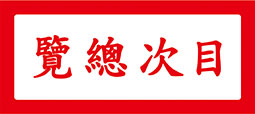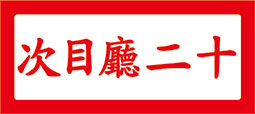My father Mr. Soong Hsün-leng published The Fragrant Hermitage with twenty nine tz’u poems. Lyric three is:
To the tune Lung yin ch’ü (龍吟曲)
In the late autumn of 1948, I returned to Hangchou, after an absence of more than ten years. So much had changed, so many people that I had once known were no more. I felt a deep sense of grief and loss, and wrote this poem in a mood of profound melan-choly. The sounds of autumn soughing on the lake seemed to echo the mournful music of my mind.
My drifting steps return
To West Lake;
After ten years
Who knows
This wild goose
Migrating home
To the south?
Crimson bridges and
Fancy pillars,
Green waves and
Painted boats,
Ducks loitering
In the sunset clouds.
The chrysanthemum garden
In the depths of autumn;
The long streets deserted,
Music of strings and flutes
Drifts from a few houses.
I sigh at the gates and alleys of olden times,
Ts'ui Hu returning,
Never to see again
The face of his Fairy Consort.
I steel myself to pass by
The house on
Hui Hsing Road,
With its old echoes
Of love.
Heart-rending memories return:
Of twin swallows
On the painted beam,
Of a deep dream
Behind kingfisher-blue curtains,
Of eternal spring
On the brocade screen,
Of passionate attachment.
Fair Purple Jade
Has vanished,
Among men as in heaven.
Heart broken,
Gut wrenched.
And there
In the early light of morning,
Stands Su Dyke,
Summoning
The soul of autumn.
(The tz’u poem above was translated by Prof. John Minford.)
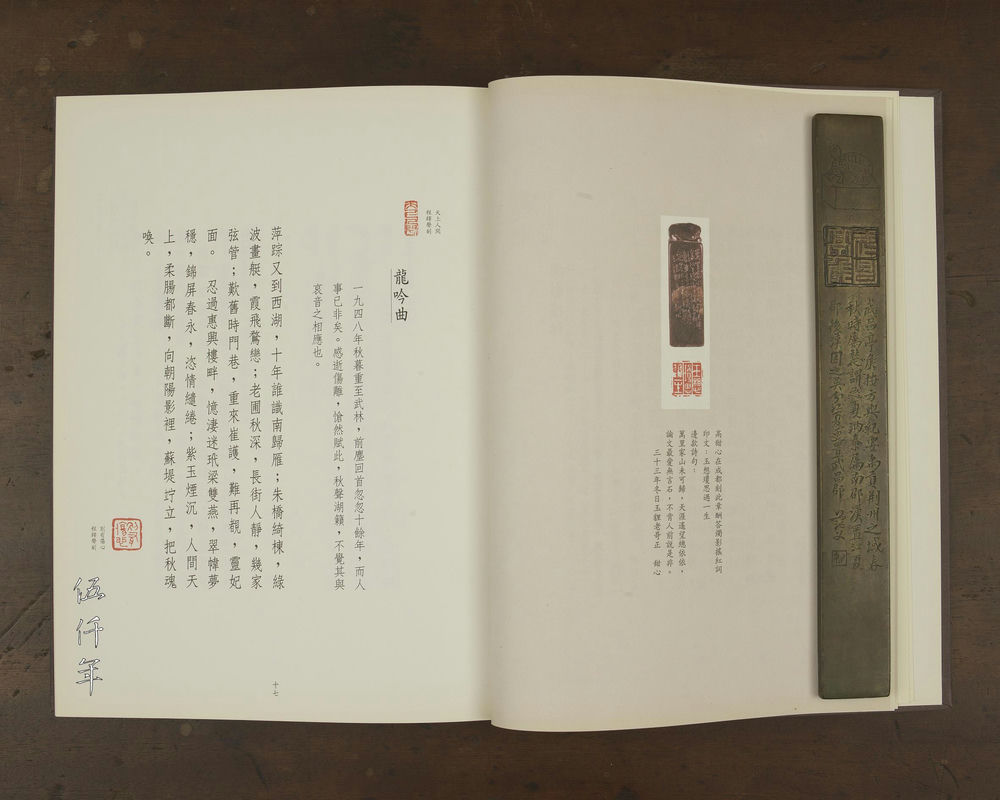
The third tz’u poem in The Fragrant Hermitage is To the tune Lung yin-ch’ü, there are two seal impressions printed on the upper right and lower left of the page, both carved by Ch’eng To-sheng
On the upper right and lower left of the page titled To the tune Lung yin ch’ü, there are two seal impressions, both carved by my father’s close friend Ch’eng To-sheng (程鐸聲). One reads: T’ien-shang jen-chien ( Heaven Above the Mortal World 天上人間), another reads: Pieh-yu shang-hsin (To have Other Heartbreak 別有傷心). These should be sentences my father composed when he commissioned the seals between the 37th year (1948) and the 38th year (1949) of the Republic.
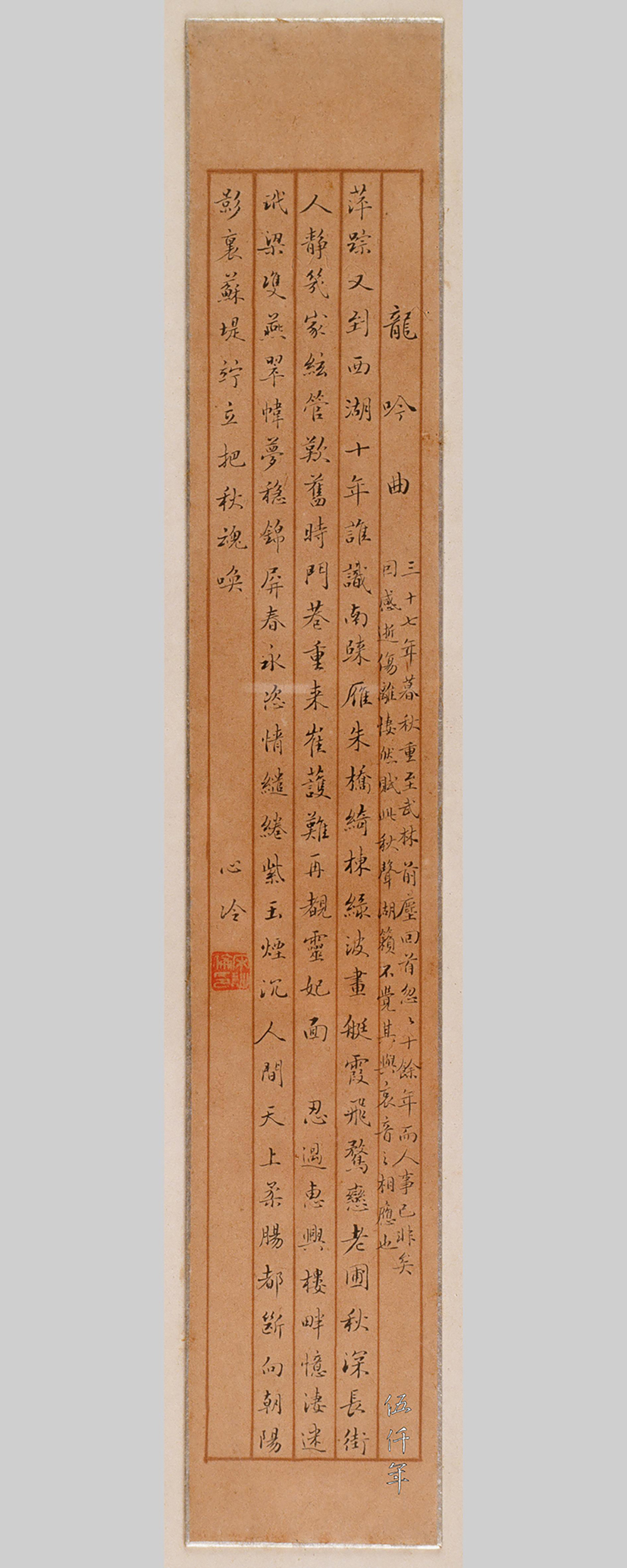
Small calligraphy piece To the tune Lung yin ch’ü by Mr. Soong Hsün-leng after he relocated to Hong Kong in 1949. The Studio of Prunus Ode Collection
My father’s studio had always hung his calligraphy of the poem To the tune Lung yin ch’ü in small regular script, signed Hsin-leng (心冷), with a seal impression: Seal of Soong Hsün-leng. In the 38th year of the Republic (1949), mainland China fell to the communists, my father sought refuge in Hong Kong, and changed his tzu to Hsin-leng (心冷), in his late years, he reverted to use his original name. Evidently this calligraphy was written in his early years after arriving in Hong Kong. A little before this, my father separately copied the poem To the tune Lung yin ch’ü on a letter sheet, signed Hsin-leng (心冷), its foreword slightly different, with only four short sentences: “After the Japanese war cloud had calmed, I returned to Wulin (another name of Hangchou), I felt a deep sense of grief and loss, and wrote this poem in a mood of profound melancholy.”
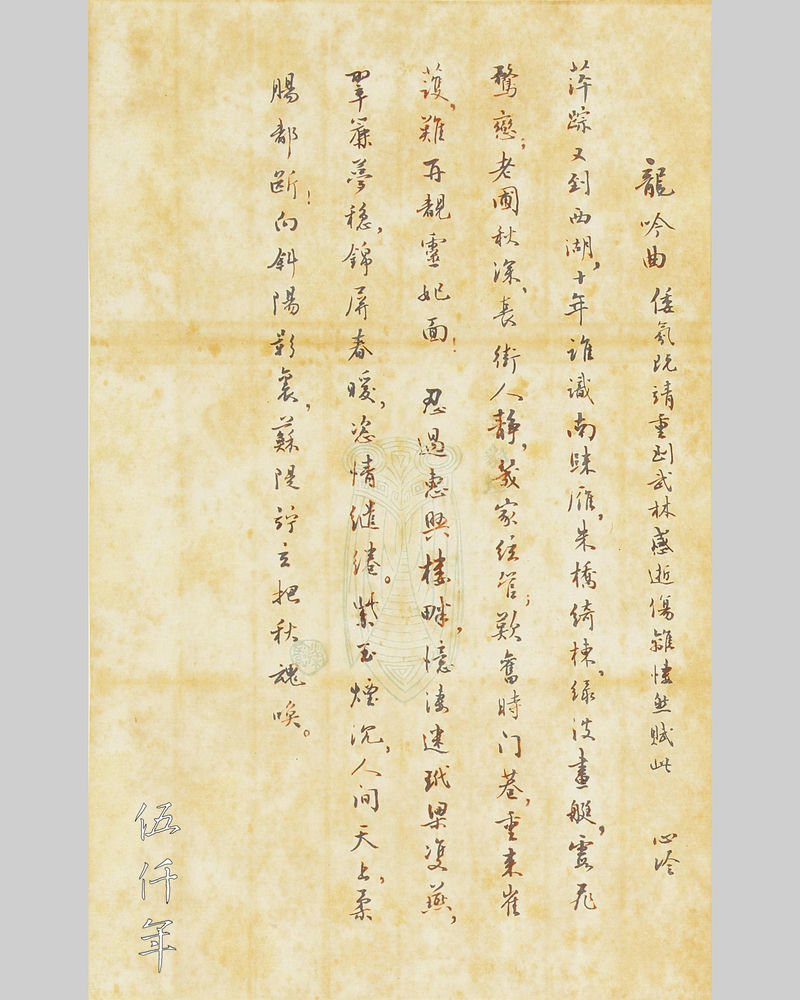
Calligraphy sheet To the tune Lung yin ch’ü by Mr. Soong Hsün-leng. The Studio of Prunus Ode Collection
To the tune Lung yin ch’ü was composed in the autumn of the 37th year of the Republic (1948), my father was then thirty nine years old. It had been three years since he returned to Shanghai from Chungking, after China’s victory over Japan in the Sino-Japanese war. During this visit to Hangchou, he had three photographs taken for remembrance.
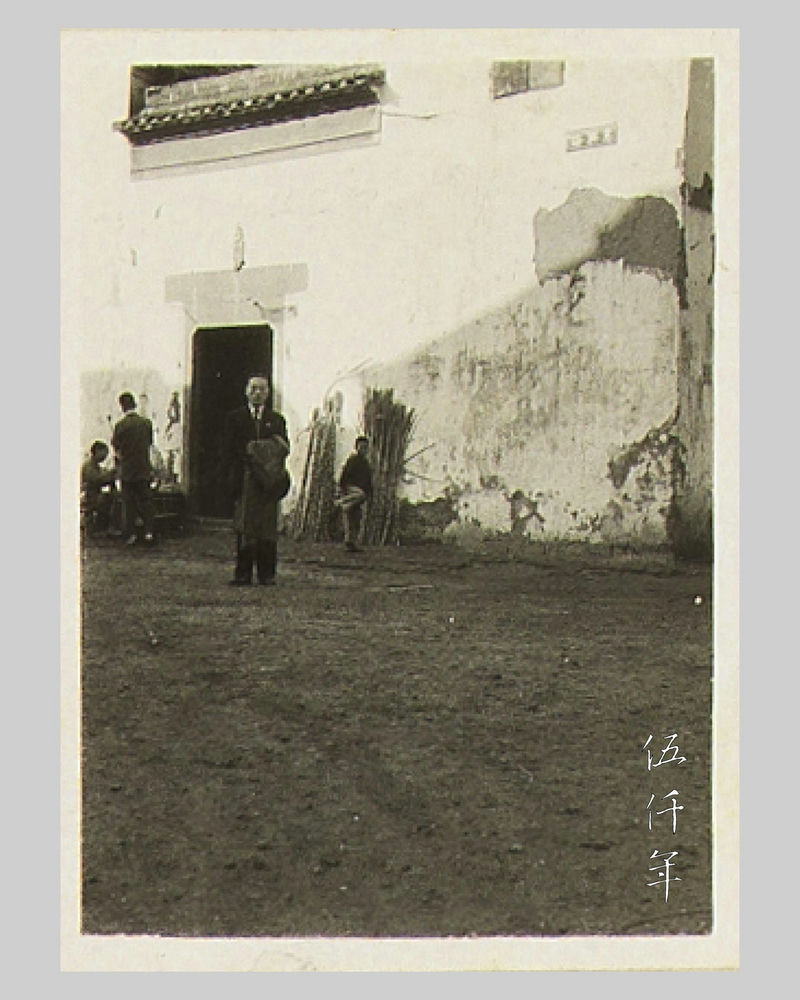
First photograph of Mr. Soong Hsün-leng in Hangchou, 1948. The Studio of Prunus Ode Collection
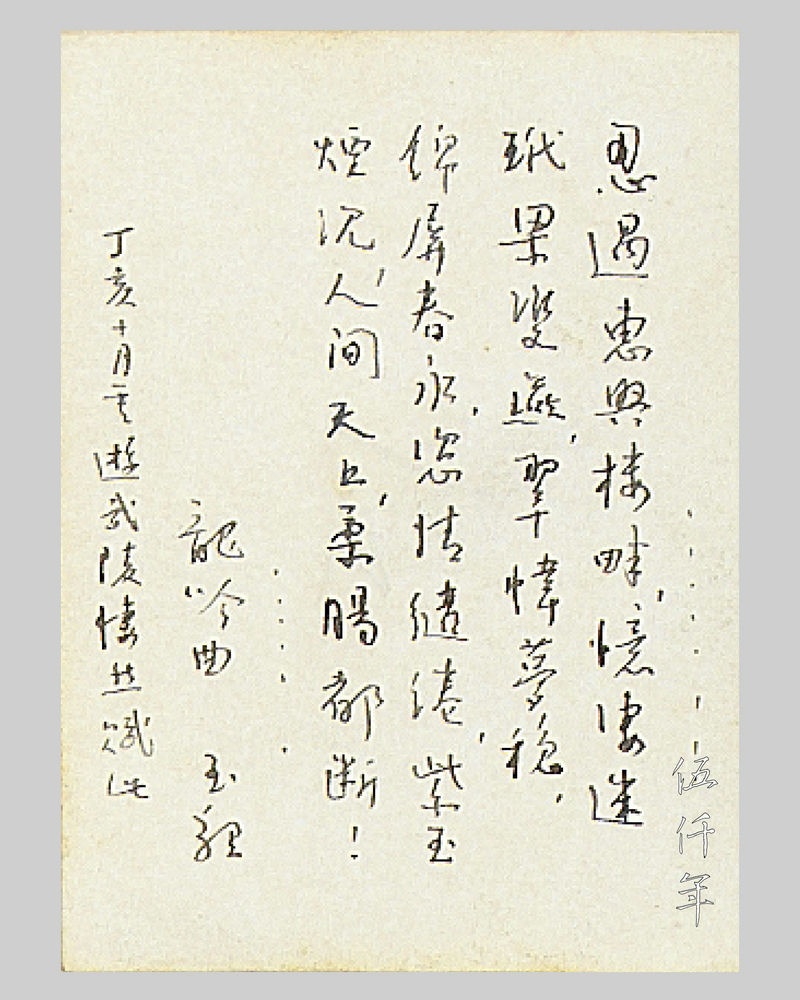
Back of first photograph inscribed by Mr. Soong Hsün-leng. The Studio of Prunus Ode Collection
The first photograph was taken with my father standing in front of the entrance of a grand wall. At the back of the photograph he inscribed the second half of the poem To the tune Lung yin ch’ü, signed Yü-li (玉貍). The foreword is even shorter:
“In October of ting-hai year (丁亥 1948), I returned to Wulin (another name of Hangchou) and wrote this poem in a mood of profound melancholy.”
Yü-li (玉貍) was the tzu my father adoped before the 39th year of the Republic (1950), it was frequently used and seen in newspapers in Shanghai, so these hand written words were from the period when he was in mainland China. One may speculate that the house on Hui Hsing Road in the tz’u poem, is behind the grand wall in the photograph.
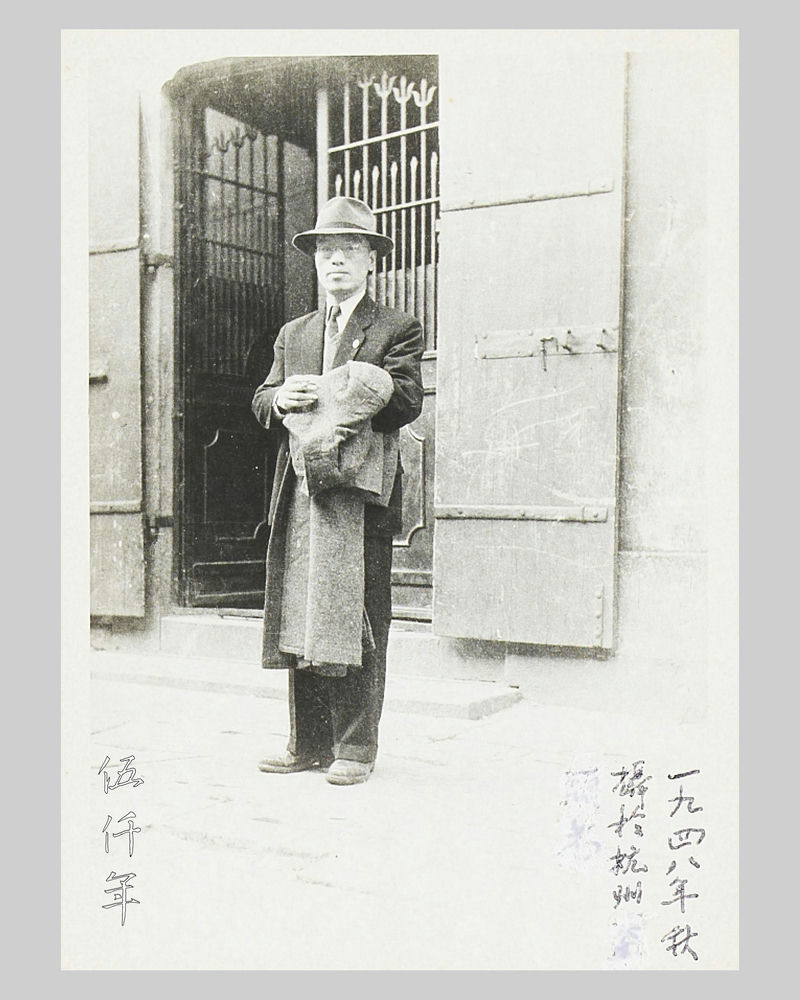
Second photograph of Mr. Soong Hsün-leng in Hangchou, 1948. The Studio of Prunus Ode Collection

Back of second photograph inscribed by Mr. Soong Hsün-leng. The Studio of Prunus Ode Collection
The second photograph was taken with my father standing outside the front door of a house, in the lower right corner of the photograph, some words were written:
“Autumn 1948, taken at Hui T’ou Lane in Hangchou.”
The three words Hui T’ou Lane had been pasted over with white correction fluid, and the words were nearly unrecognizable. In former times, amorous liaisons were not to be heard and spoken of by outsiders, my father concealed this episode, and he was not willing to carelessly leave evidences. He inscribed the complete poem To the tune Lung yin ch’ü at the back of the photograph, and signed Leng (倫). The signature Leng indicates the writing is an addition from his late years. The house in the photograph, is most likely the house on Hui Hsing Road in the tz’u poem.
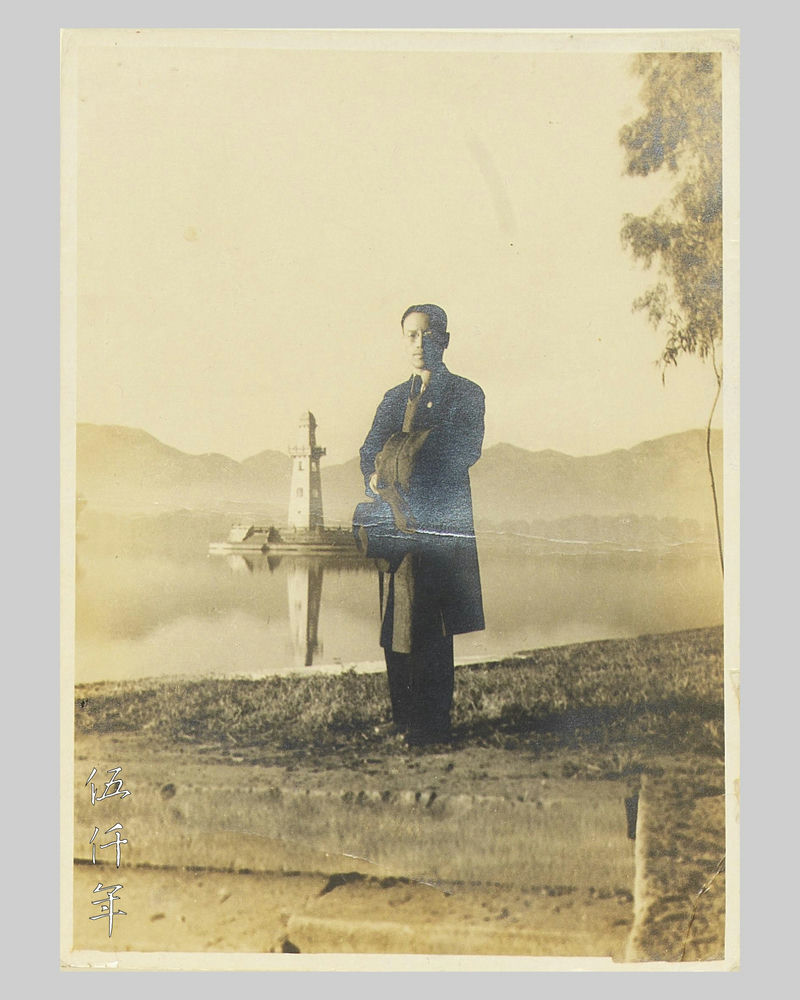
Third photograph of Mr. Soong Hsün-leng in Hangchou, 1948. The Studio of Prunus Ode Collection
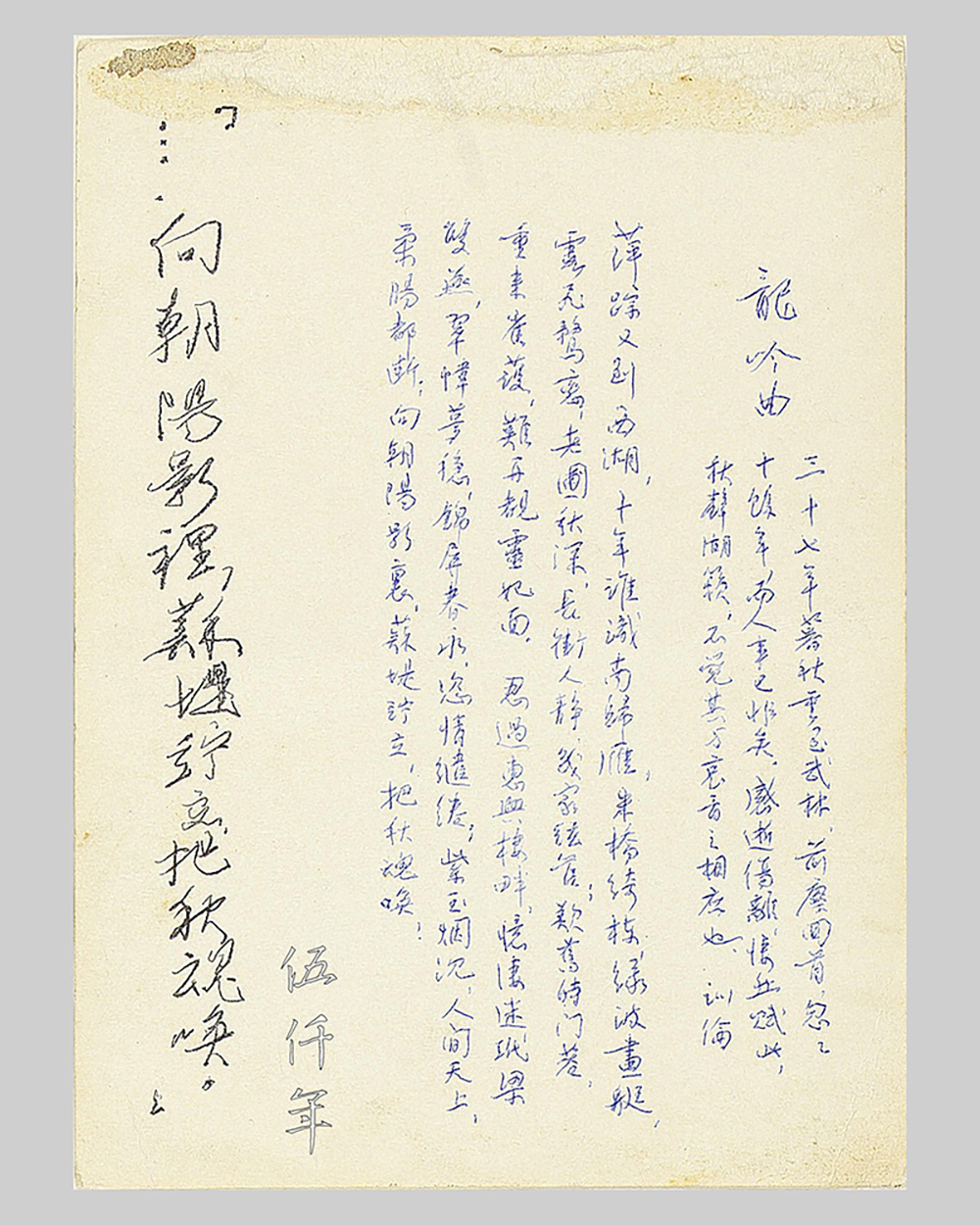
Back of third photograph inscribed by Mr. Soong Hsün-leng.The Studio of Prunus Ode Collection
The last photograph was taken with my father standing in front of West Lake, there was a pagoda in the far distance. At the back of the photograph, my father inscribed the complete poem To the tune Lung yin ch’ü, and signed Hsün-Leng. The foreword uses the calendar of the Republic, the handwriting is therefore slightly earlier than that of the second photograph, only in the last thirty years that informal circles in Hong Kong changed the Republican calendar to Gregorian calendar. At the back of the photograph, the last line of the tz’u poem was additionally inscribed:
“And there
In the early light of morning,
Stands Su Dyke,
Summoning
The soul of autumn.”
These words are indeed the tz’u imagery of this last photograph.
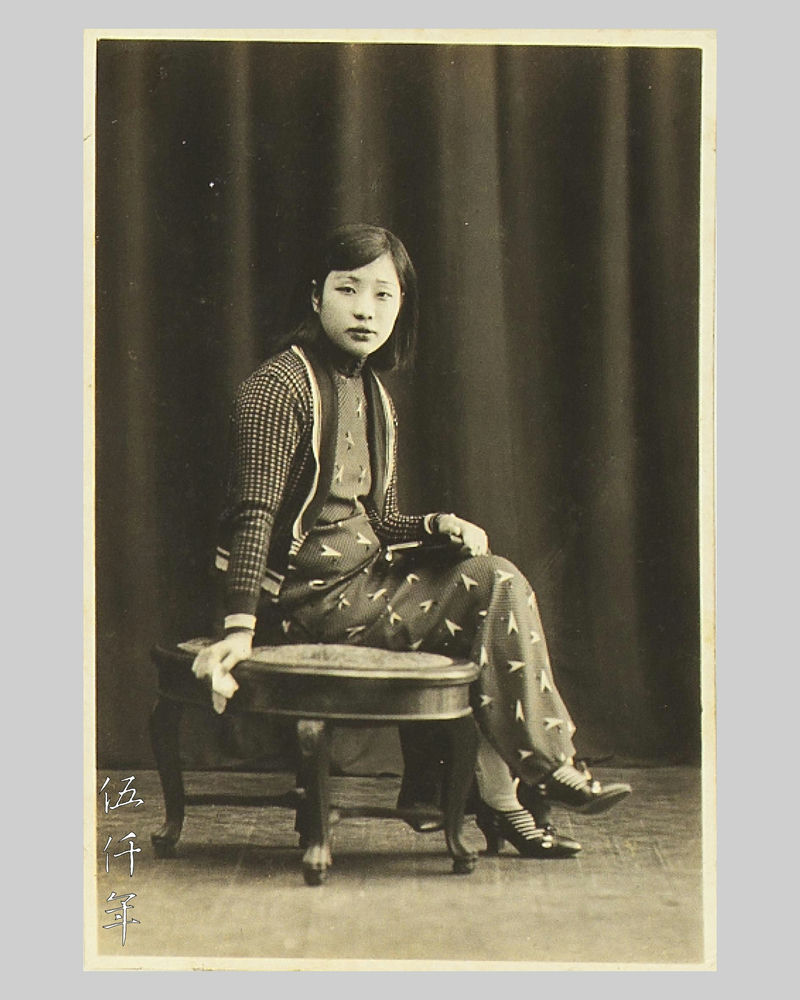
Portrait of Ch'in-hsin (琴心) from Hangchou. The Studio of Prunus Ode Collection

Back of portrait of Ch'in-hsin (琴心) inscribed and pasted over by Mr. Soong Hsün-leng. The Studio of Prunus Ode Collection
In my father’s belongings, a photograph of a young lady was found. At the back of the photograph, words were also pasted over with white correction fluid and hard to identify. Reading the vague lines, some words are still recognizable:
“……………Ch’in-hsin (the heart of Ch’in 琴心), heart broken gut wrenched,
………….happiness……..room……remorse,
Sixty years ago became just a dream.
Written in the winter of 1992,
when examining the photograph of the departed.”
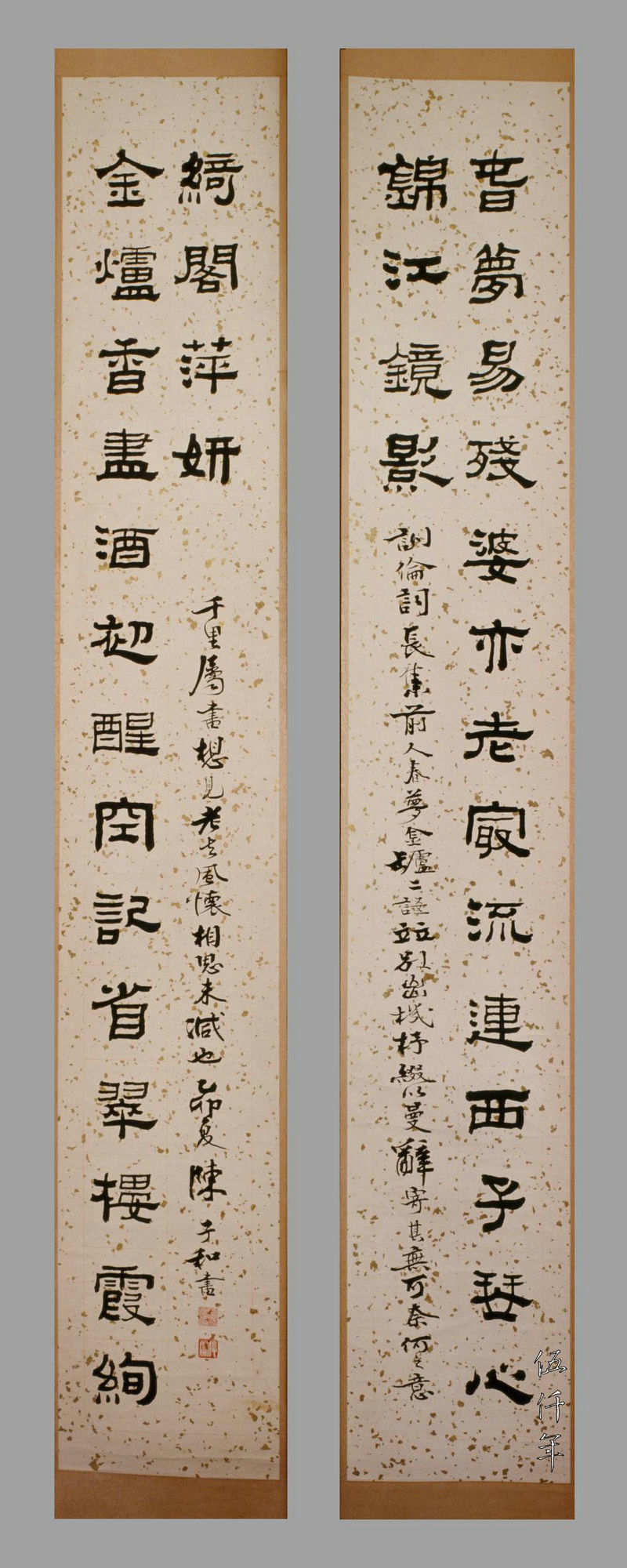
Clerical script couplets by Mr. Ch’en Tzu-ho for Mr. Soong Hsün-leng
I recall in the 64th year of the Republic (1975), my father put together a sentence composed by Wu Hsi-ch’i (吳錫麒 1746-1818): “Spring dreams are easy to wither and my lady has now grown old”, and a sentence composed by Ou-yang Chiung (歐陽炯 896-971): “Incense in the golden burner has incinerated and I am awakened from drunkenness”. He matched these two sentences with his own compositions, and asked a calligrapher friend in Taiwan, Mr. Ch’en Tzu-ho (陳子和 1910-1984), to write a pair of calligraphy couplets, to reminisce the four ladies he was affected in his youth. The couplets read:
“Spring dreams are easy to wither and my lady has now grown old, mostly I linger by the heart of Ch’in (琴) from West Lake and the reflection of Ching (鏡) from Chin Lake,
Incense in the golden burner has incinerated and I am awakened from drunkenness, recollecting in vain the radiance of Hsia (霞) at Sheng-ts’ui Lou (省翠樓) and the lusciousness of P’ing (萍) at Ch’i Ko (綺閣).”
The colophons on the couplets by Mr. Ch’en Tzu-ho read:
“ My tz’u poet friend Hsün-leng put together the phrases ‘Spring dreams’ and ‘Incense in golden burner’ by past masters, woven his own original lyrics, and embellished them with tender expressions, so as to convey helplessness. He requested these couplets from thousands of miles away. It is conspicuous that despite old age, his lovelornness has not diminished. In the summer of i-mao (已卯 1975), calligraphy by Ch’en Tzu-ho.”
Reading the sentence: “Mostly I linger by the heart of Ch’in (琴心) from West Lake”, I was struck by a flash of comprehension, the person in the photograph was the same person in the tz’u poem.
The foreword of the poem To the tune Lung yin ch’ü reads: “ I returned to Hangchou, after an absence of more than ten years.” The tz’u poem also reads:
After ten years
Who knows
This wild goose
Migrating home
To the south?
At the back of the photograph of Ch’in-hsin (琴心), this was written: “Sixty years ago became just a dream.” From these descriptions one can deduce that my father met Ch’in-hsin (琴心) before the 27th year of the Republic (1938), when he was not quite twenty nine years old. In the winter of 1992, when my father examined the photograph of his departed friend, he was already eighty three. Perusing a relic from past memory, he was overwhelmed by a multitude of feelings, and wrote an inscription at the back of the photograph, but in no time, he was worried that the amorous liaison would taint the lady’s reputation, eventually rectifying and deleting all evidences.
I respectfully compiled my father’s hand writings of the tz’u poem To the tune Lung yin ch’ü, transcribing them in fine details. Since ancient times, stories of the bygone have been suspended on a thin line between oblivion and revelation, more so in our world where classical studies are enfeebled and in decline. Those who empathize are hard to come across. It is perhaps permissible to wait, solitarily, for those yet to appear.
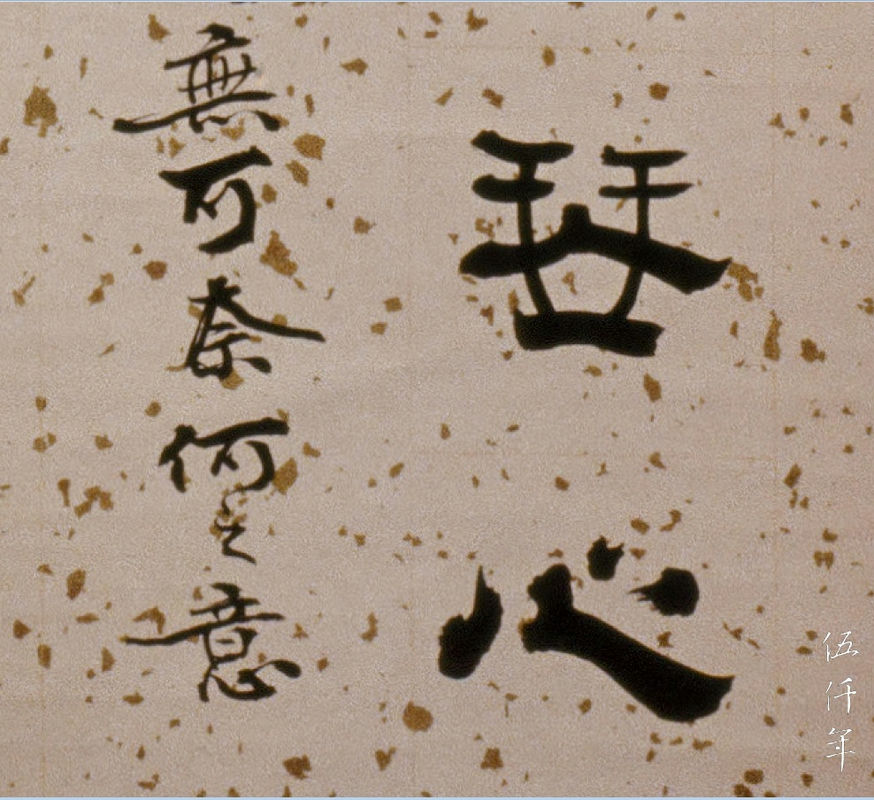
The characters “Ch’in-hsin” in clerical script by Mr. Ch’en Tzu-ho
